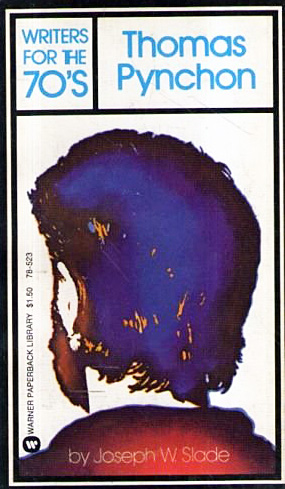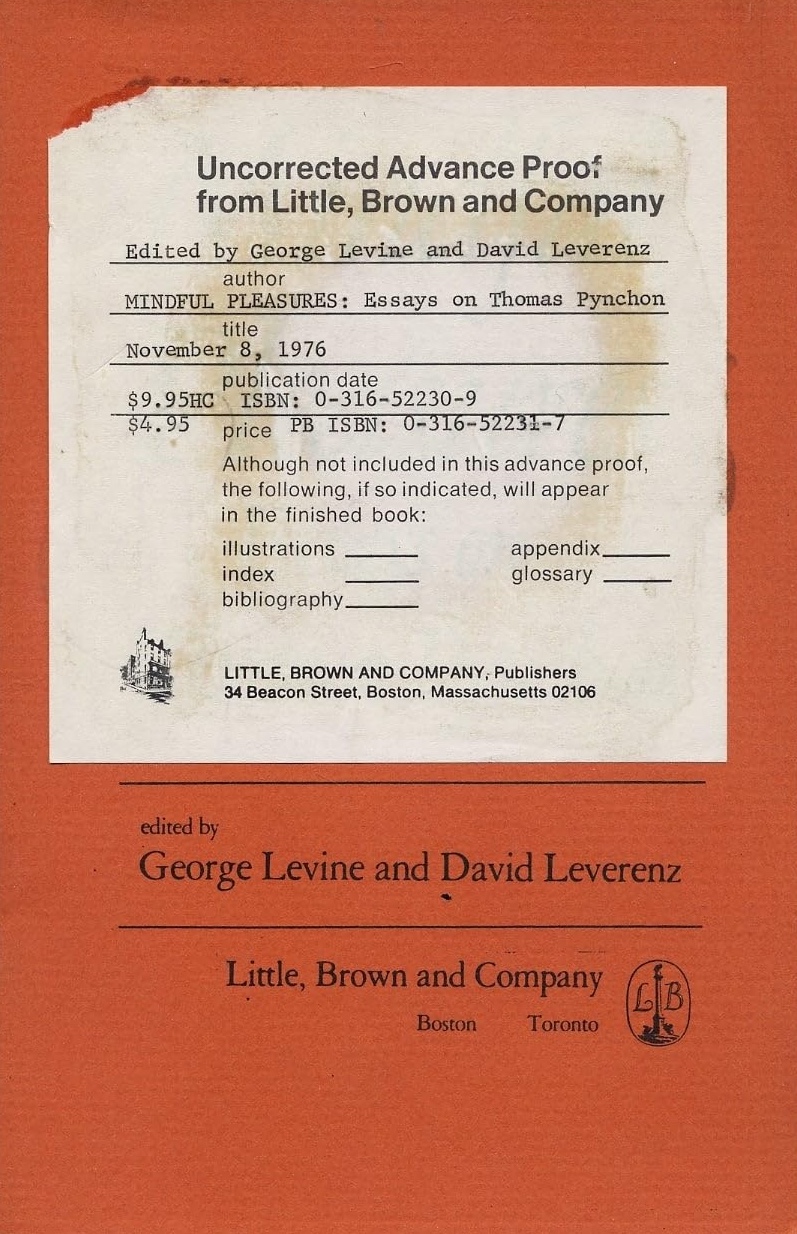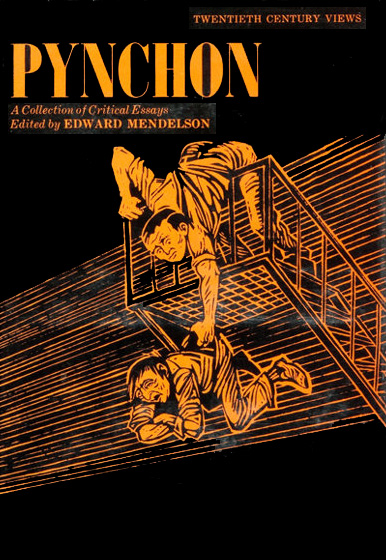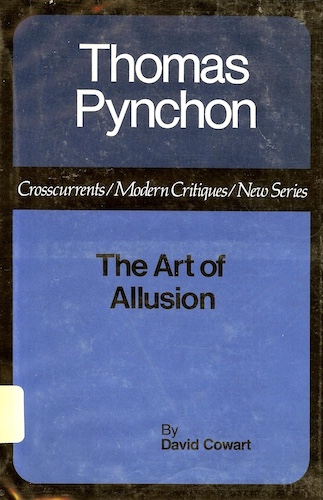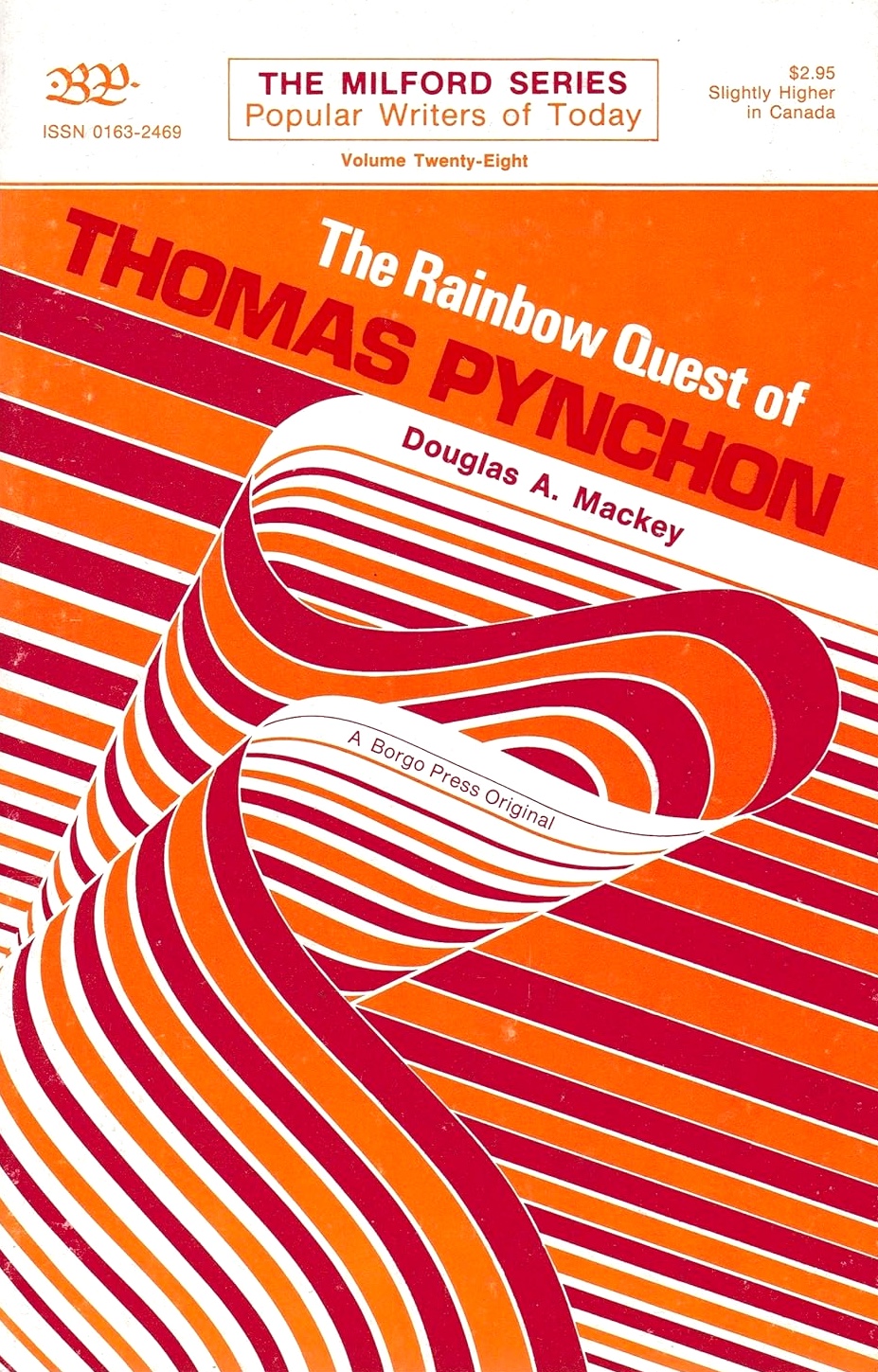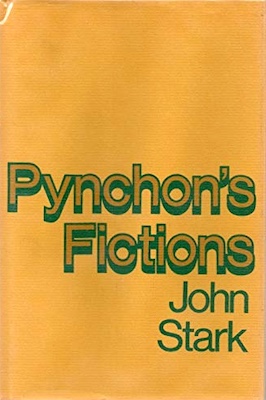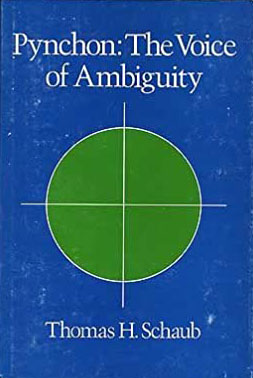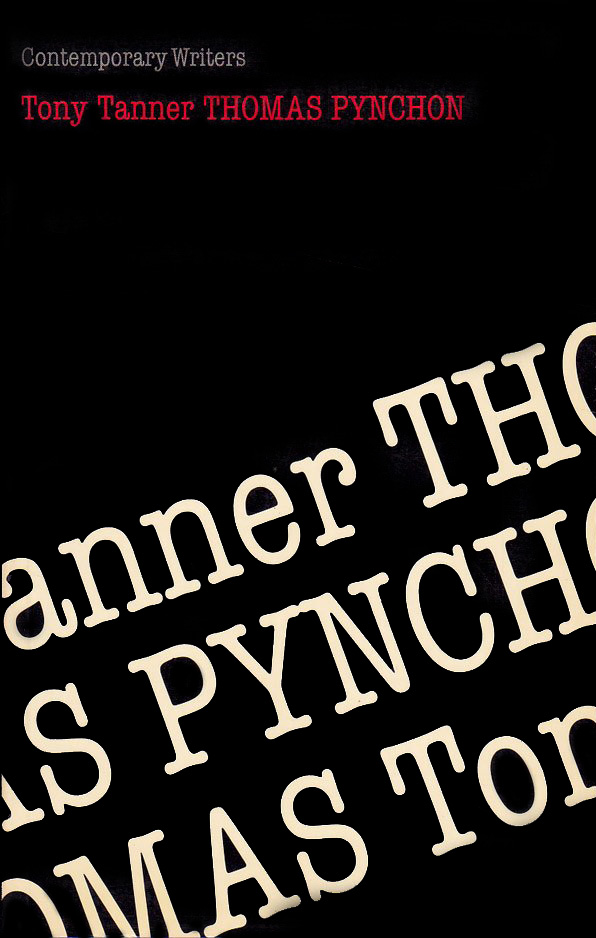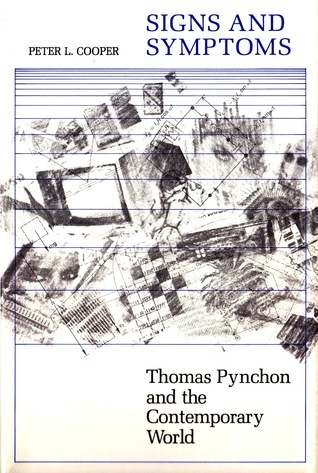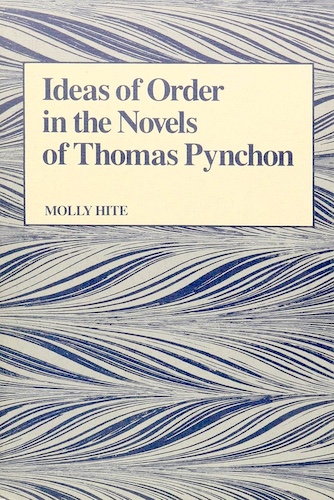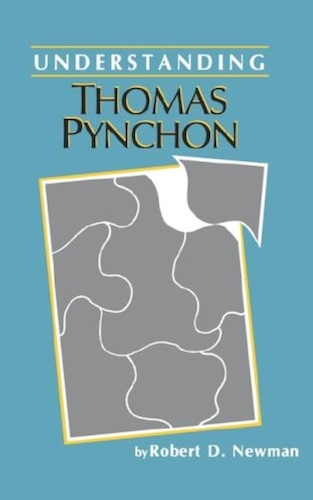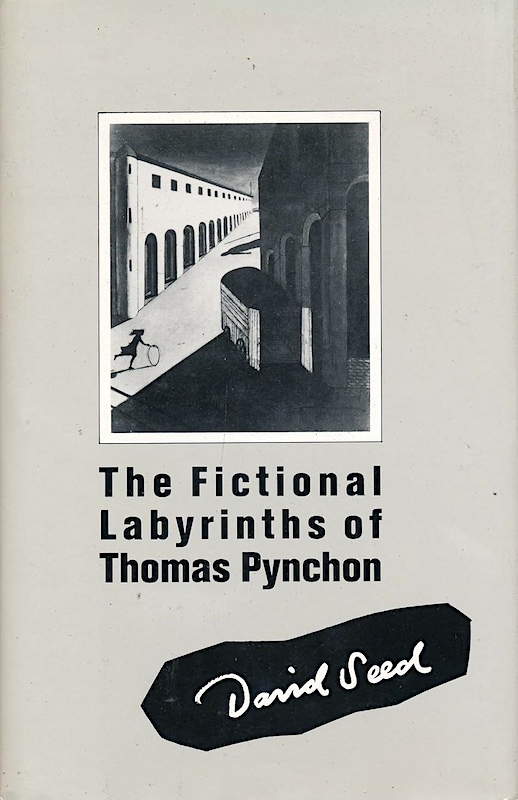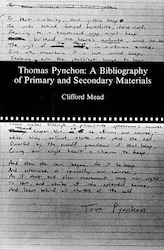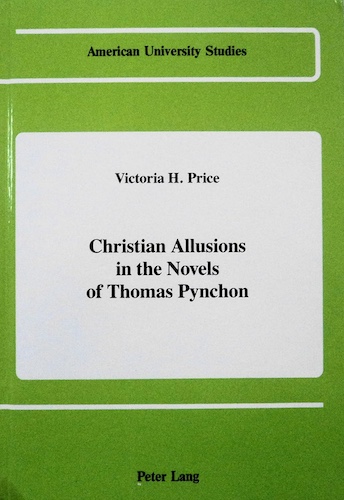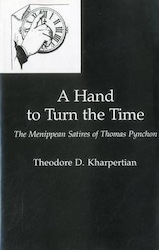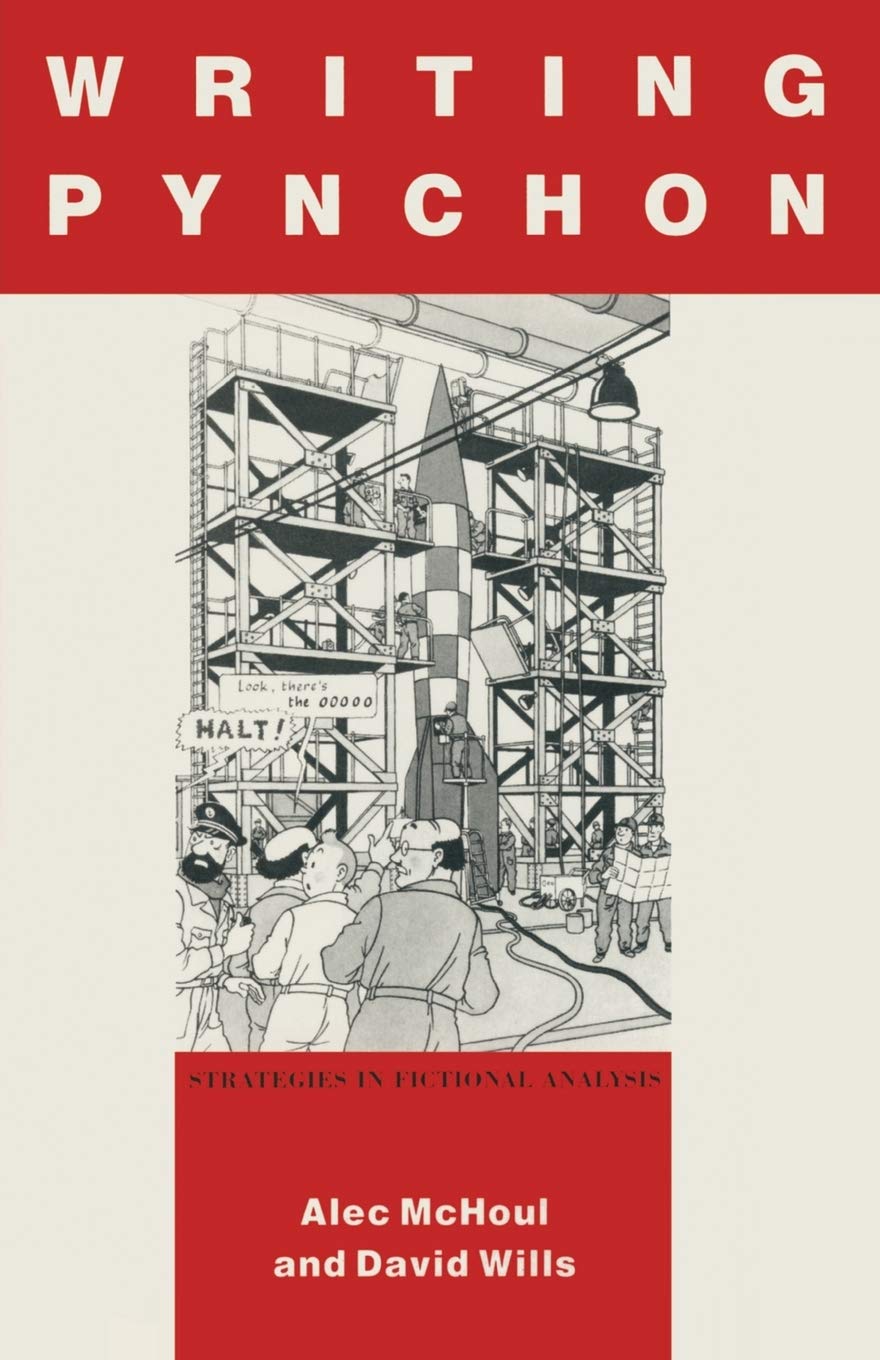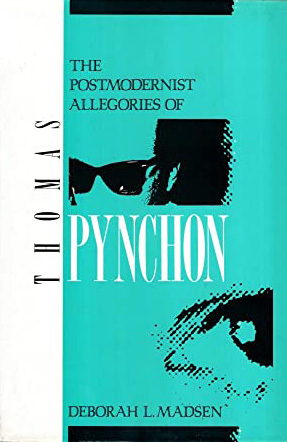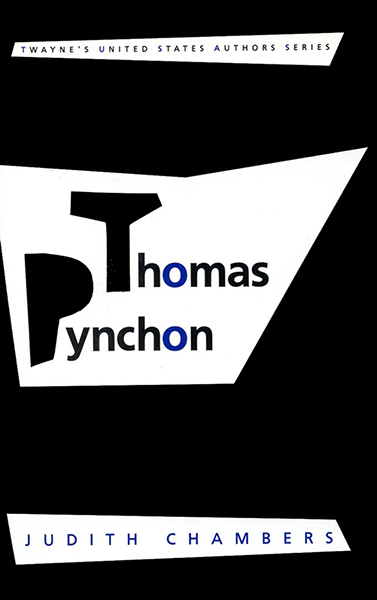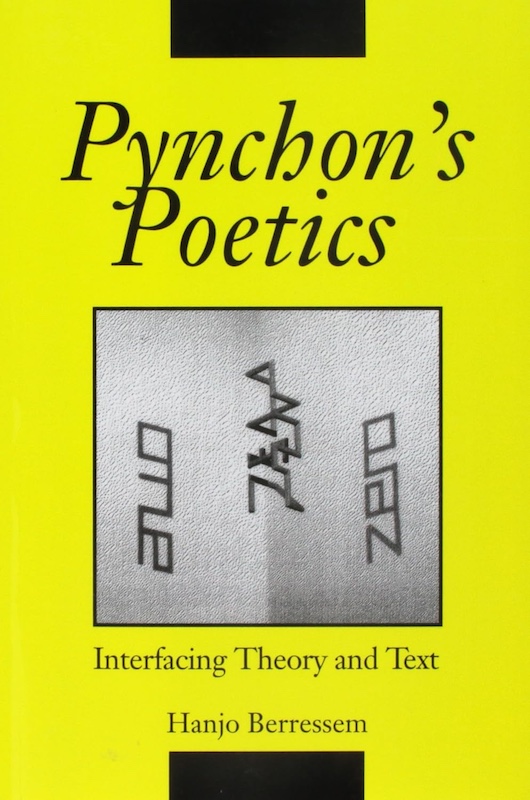Pynchon Criticism: Selected General Criticism 1
- At January 11, 2021
- By Spermatikos Logos
- In Pynchon, The Modern Word
 0
0
This is a first collection of criticism about Pynchon; perhaps with time and distance his critical reception will become more relaxed.
—“Kirkus Reviews,” 1976
Pynchon Criticism: General Criticism 1: 1974–1999
This page collects general Pynchon literary criticism; as opposed to works written about particular novels. These books were all written from 1974 to 1999; for later criticism, see “General Criticism 2: 2000-Present.” Most of the books profiled in this section are accompanied by a brief description, a summary of contents, and the official publisher’s blurb. If any visitor would like to contribute informed commentary for any of these works, please contact Spermatikos Logos! The books are listed in chronological order of publication. Clicking the image of a book takes you directly to Amazon.
Writers for the 70’s: Thomas Pynchon
Warner, 1974
You have to think back fondly to a time when Warner mass market paperbacks printed literary criticism! Although it’s certainly been superseded by other works, Slade’s Thomas Pynchon is still among the first. But who is that guy on the cover?
Publisher Description: This pioneering work, first published in 1974, is still regarded as the best introduction to the fiction of America’s premier novelist. Six chapters explore the themes of Pynchon’s short fiction, V., The Crying of Lot 49, and Gravity’s Rainbow, while a section added especially for this edition extends the assessment of the author’s stature and impact on modern literature. The book is particularly helpful to those readers interested in Pynchon’s encyclopedic approach to writing, since Slade clearly identifies the cultural, technological, and scientific elements woven into the novels.
Mindful Pleasures: Essays on Thomas Pynchon
Little, Brown, 1976
Along the first published works of Pynchon criticism, this seminal collection is named after Pynchon’s working title for Gravity’s Rainbow, “Mindless Pleasures.”
Contents:
- Bruce I. Herzberg: Bibliography
- Marjorie Kaufman, “Brünnhilde and the Chemists: Women in Gravity’s Rainbow”
- David Leverenz, “On Trying to Read Gravity’s Rainbow”
- George Levine, “Mindful Pleasures”
- George Levine, “Risking the Moment: Anarchy and Possibility in Pynchon’s Fiction”
- T. Lhamon, “Pentecost, Promiscuity, and Pynchon’s V.: From the Scaffold to the Impulsive”
- Anne Mangel, “Maxwell’s Demon, Entropy, Information: The Crying of Lot 49”
- Edward Mendelson, “Gravity’s Encyclopedia”
- Richard Poirier, “The Importance of Thomas Pynchon”
- Scott Sanders, “Pynchon’s Paranoid History”
- Catherine R. Stimpson, “Pre-Apocalyptic Atavism: Thomas Pynchon’s Early Fiction”
- Tony Tanner, “Caries and Cabals”
- William Vesterman, “Pynchon’s Poetry”
Kirkus Reviews (1976): Large claims are made for the accomplishments of the very elusive Thomas Pynchon within these eleven essays; the essayists bump and jostle one another in their eagerness to seat Pynchon in the company of Melville, Joyce, and even Goethe. After the editors’ apologia to Pynchon—they feel they’ve forced him, perhaps, into the kind of solemn gathering he’s always wanted to avoid—Richard Poirer takes over as main host, scolding Pynchon’s audience for showing ignorance, dullness, and a serious countenance in their response to him so far. Then we’re let off the hook and given some fine close readings of the texts themselves. Tony Tanner, for example, in an excerpt from City of Words, deals trenchantly with aspects of paranoia and its alternative, entropy, in the early stories and in V.; Anne Mangel has acquired a store of fascinating technical intelligence to explain the place of the physicist Maxwell’s Demon and information theory in The Crying of Lot 49; and Scott Sanders finds a Calvinist strain in Gravity’s Rainbow that poses an entropic counterpart to the Day of Judgment. Edward Mendelson goes so far as to name a new literary genre—the “encyclopedic narrative,” striking in itself—to describe the extraordinary range of scientific, cultural, and linguistic learning that distinguishes books like the Commedia, Faust, and Gravity’s Rainbow from scores of other historic masterpieces. This is a first collection of criticism about Pynchon; perhaps with time and distance his critical reception will become more relaxed. Meanwhile, these essays will frustrate and enrich the Pynchon reader.
The Grim Phoenix: Reconstructing Thomas Pynchon
Indiana University Press, 1978
One of the first books of Pynchon criticism, Grim Phoenix was reviewed by Richard Pierce in Studies in American Fiction, Volume 7, Number 1, Spring 1979, pp. 110-112. An excerpt of Pierce’s review offers a taste of Plater’s book:
“The grim phoenix,” Leni Polker’s metaphor for the contemporary life force, “creates its own holocaust . . . deliberate resurrection. Staged. Under control. No grace, no interventions by God.” Restrained, calculating, bent on death, the grim phoenix neither depends upon nor opens the way toward anything beyond its own destructive cycle. It is even more terrifying than Yeats’s rough beast slouching toward Bethlehem to be born. And William Plater seizes upon the grim phoenix as the controlling metaphor for his study of Thomas Pynchon, showing his world to be a closed system, governed by forces that transform life into death, culminating not in resurrection, as it has been religiously conceived , but in death transfigured. While “the grim phoenix” is a compelling metaphor, what illuminates Plater’s central and original thesis is Kekule’s dream of the Great Serpent swallowing its own tail. For it was Kekule’s dream that led him to discover die shape of the benzene ring, which formed the basis for synthetic chemistry and the synthetic industry. Kekule’s Serpent achieved the ultimate form of consumption; the Serpent’s dream became the ultimate form of Western power. The creation of synthetics is the process of transforming natural into artificial products , or life into death. And the process is reflected in the multinational industries—from I.G. Farben to Yoyodyne—that cross boundaries of geography and the imagination while subsuming competition and individual differences, creates new markets while absorbing old ones, uses war to consolidate its own power, stimulates appetites for its own nourishment, and consumes every kind of natural energy for its own sustenance.
Another contemporary review may be found in Studies in English, New Series: Vol. 1, by Craig Warner. And here’s a less academic take by an offsite reviewer:
William M. Plater, a respected Indiana academician and college dean, gives an amazing analysis of Pynchon’s fiction up to and including Gravity’s Rainbow using not only literary references, but philosophical, mathematical, sociological, and mythological as well. He references Pynchon back to some of his own source material such as The Education of Henry Adams and Wittgenstein’s Tractatus Logico-Philosophicus. He delves not so much into the structure of Pynchon’s dense prose, but the reasons behind it, the ideas behind it, and where Pynchon resides in the mental and literary landscape. Plater outlines the major themes of Pynchon’s fiction (eg, death transfigured, paranoia, reality and its projected image) and weaves them into a very readable and thought-provoking examination of the greatest American writer of the latter 20th century and certainly the archetype of postmodernism. If you read Pynchon, you should also read Plater.
Pynchon: A Collection of Critical Essays
Prentice-Hall, 1978
This early collection of essays about Pynchon’s work was edited by Edward Mendelson, a major figure in Mindful Pleasures and one of the first serious Pynchon scholars.
Contents:
- Edward Mendelson: Introduction
- Tony Tanner, “V. and V-2”
- F.S. Schwarzbach, “A Matter of Gravity”
- Jonathan Rosenbaum, “A Reply”
- Joseph W. Slade, “‘Entropy’ and Other Calamities”
- Robert Sklar, “An Anarchist Miracle: The Novels of Thomas Pynchon”
- Rober B. Henkle, “Pynchon’s Tapestries On the Western Wall”
- Edward Mendelson, “The Sacred, the Profane, and The Crying of Lot 49”
- James Nohrnberg, “Pynchon’s Paraclete”
- Frank Kermode, “Decoding the Trystero”
- Gravity’s Rainbow: Three Reviews
- Richard Poirier, “Rocket Power”
- George Levine, “V-2”
- Philip Morrison: Review for Scientific American
- Michael Seidel, “The Satiric Plots of Gravity’s Rainbow”
- Paul Fussell, “The Brigadier Remembers”
Thomas Pynchon’s Art of Illusion
Southern Illinois University Press, 1980
Publisher Description: This fresh examination of Pynchon’s use of painting, film, music, and literature shows that his true art lies in humanistic allusions that stress the possibility of spiritually separating oneself from the modern wasteland. Cowart disagrees with critics who see Pynchon as a scientist writing about entropy, although Pynchon does illustrate the nihilistic world for which he is famous in allusions to painting and film, both of which mask a Void. But more important, these allusions call into question what is real and what is not. Through musical and literary allusions Pynchon suggests the speculative world, the world of unrealized possibility. Music hints at the dimensions of experience people miss because of the narrow range of experiences to which they are attuned. Literary allusions support and extend the almost mystical sense created by musical allusions, thus suggesting that in Pynchon’s view, human consciousness need not be trapped by entropic drift.
The Rainbow Quest of Thomas Pynchon
Bongo Press, 1980
Volume No. 28 of the Milford series, “Popular Writers of Today.” D.F. Larsson reviewed Mackey’s book in Pynchon Notes 7, p.49-52, under the title of “Approach and Avoid.”
Publisher’s Description: Like J.D. Salinger and B. Traven, Thomas Pynchon is secretive to the point of compulsion. The basic facts are known—Pynchon was born in 1943, attended Cornell University, studying engineering and physics while majoring in English, served a hitch in the Navy, worked as an engineering aide for Boeing—but the man himself never appears. There are no photographs of Pynchon, and his address is unknown; he never lectures on talk shows or at college campuses; no interviews have ever been published. He prefers to let his work speak for itself. Pynchon has written only three novels…and although these have attained some measure of popular success, he has a reputation as being a “difficult” writer. But the very elements of his work that are called difficult also make it richly rewarding for the discerning reader. Douglas Mackey is such a reader, and his intelligent and critical commentary will provide the student of Pynchon with interesting insights into the complex universe of this master story-teller.
Pynchon’s Fictions: Thomas Pynchon and the Literature of Information
University of Ohio Press, 1980
Publisher’s Description: Investigates Pynchon’s metaphorical use of scientific theories and information to help unify fictional worlds that seem on the edge of chaos.
Pynchon: The Voice of Ambiguity
University of Illinois Press, 1981
Schaub’s book was reviewed by Beverly Lyon Clark in Studies in American Fiction. An excerpt from the review introduces the book nicely:
Thomas Schaub joins the swelling chorus of Pynchon criticism by celebrating Pynchon’s song, his complex and ambiguous harmonies. Schaub’s work…is clearly one of the better pieces, addressing the central issue in reading Pynchon: the disorienting ambiguity. Schaub focuses on Pynchon’s ambiguity, his complexity, which requires a judicious reader willing to forgo certainty. His characters and his readers try to construct unities out of discrete particulars, but such attempts always fail… In succeeding chapters Schaub ranges widely among science, religion, psychology, sociology, literature, proceeding with a kind of associative logic that at times makes him difficult to follow. But reading him is worth the effort. Early on Schaub covers familiar ground, as when he discusses entropy and ambiguity in The Crying of Lot 49… Schaub then discusses allusions to film, Jung, Weber, myth, mathematics—all flirting with continuity and unity as Schaub teases out their significance. He also notes opposing conceptions of history, the cyclical and the linear, the first described by Eliade, the second espoused by Pavlov. All appear in Gravity’s Rainbow but, as with all else, no perspective receives complete endorsement.
Critical Essays on Thomas Pynchon
G.K. Hall, 1982
A collection of thirteen essays about Thomas Pynchon’s first three novels, with a focus on Gravity’s Rainbow. Matthew Winston reviewed this collection book in Pynchon Notes 8, p.47-53, under the title of “Critical Cornucopia.”
Contents:
- Beverly Lyon Clark and Cary Fuoroli: A Review of Major Pynchon Criticism
- Allen J. Friedman and Manfred Pütz, “Science as Metaphor: Thomas Pynchon and Gravity’s Rainbow”
- Paul Fussell, “The Brigadier Remembers”
- Josephine Hendin, “What Is Thomas Pynchon Telling Us?”
- John W. Hunt, “Comic Escape and Anti-Vision: V. and The Crying of Lot 49”
- Speer Morgan, “Gravity’s Rainbow: What’s the Big Idea?”
- Richard F. Patteson, “What Stencil Knew: Structure and Certitude in Pynchon’s V.”
- Maureen Quilligan, “Thomas Pynchon and the Language of Allegory”
- Elaine B. Safer, “The Allusive Mode and Black Humor in Barth’s Giles Goat-Boy and Pynchon’s Gravity’s Rainbow”
- Scott A. Simmon, “Beyond the Theatre of War: Gravity’s Rainbow as Film”
- Marcus Smith and Khachig Tölölyan. “The New Jeremiad: Gravity’s Rainbow”
- Richard Wasson, “Notes On a New Sensibility”
- Steven C. Weisenburger, “The End of History?: Thomas Pynchon and the Uses of the Past”
- Lawrence C. Wolfley, “Repression’s Rainbow: The Presence of Norman O. Brown in Pynchon’s Big Novel”
Thomas Pynchon (Routledge Library Editions: Modern Fiction)
1. Methuen, 1982.
2. Routledge, 2019.
2. Routledge, 2019.
Publisher’s Description: Thomas Pynchon is now recognized as a major contemporary novelist and perhaps the most important American writer since Melville. His work is both richly imaginative and amazingly erudite and can be compared, in its complexity, linguistic playfulness and experimentation and wealth of allusion, to the work of James Joyce. Aspects of history, psychology, technology and science, cultural and political movements, problems of identity and society and the status and function of fiction and narrative in the modern world are all dramatized with extraordinary wit and power. Tony Tanner provides a brief, comprehensive introduction to his work. Against the background of Pynchon the man, this book, originally published in 1982, examines in detail his early short stories (some of which are not easily accessible) and offers a guide to the reading of his novels, V., The Crying of Lot 49 and Gravity’s Rainbow. Many of Pynchon’s recurrent themes, from entropy and information theory to his interest in the operations and divisions of power in the world since the Second World War, are considered. Finally, Tony Tanner places Pynchon and his work in a broader cultural and literary context.
Signs and Symptoms: Thomas Pynchon and the Contemporary World
Univ of California Press, 1983
Publisher’s Description: America has produced two important groups of post-war novelists, the ‘neo-realists’, who inherit the traditions of realism and naturalism, and the ‘counter-realists’, who consciously react against those traditions. Thomas Pynchon has a net affinity for the latter kind of fiction, yet, as Peter Cooper shows, he is unique among the counter-realists. Cooper examines Pynchon’s novels first against the backdrop of contemporary fiction. While sharing the general interest of the counter-realists in labyrinthine plots, intricate fantasies, and self-made realities, Pynchon differs from them in his great concern about political and sociological problems. Cooper then explores Pynchon’s view of the modern world, both its apparent ills and available remedies. Contending that Pynchon criticism has focused too narrowly on the author’s treatment of the problems of the modern world rather than the possibilities it offers, Cooper aligns himself with a more recent and persuasive trend in Pynchon studies that stresses the author’s ambivalence—his despair countered by hope. This ambivalence is present in all forms of Pynchon’s thought and expression. Pynchon’s authorial practices, especially his prose style, have received surprisingly little attention. Pynchon’s commentators typically neglect his craft in favor of his themes and materials… Cooper examines the author’s literary methods, from the structure of sentences to the structure of whole books.
Contents:
1. Pynchon’s Literary Context: The Counterrealists
2. Pynchon’s Jeremiad: A Control That Is Out of Control
3. Pynchon’s Solutions: The Moment and Its Possibilities
4. Pynchon’s Cosmos: Symbols of Randomness and Fright
5. Pynchon’s Epistemology: An Eye That Reflects and An Eye That Receives>
6. Metaphor, Model Building, and Paranoia: A Thrust at Truth and a Lie
7. Pynchon’s Fictional Techniques: Assertion Through Structure
Selected Bibliography
2. Pynchon’s Jeremiad: A Control That Is Out of Control
3. Pynchon’s Solutions: The Moment and Its Possibilities
4. Pynchon’s Cosmos: Symbols of Randomness and Fright
5. Pynchon’s Epistemology: An Eye That Reflects and An Eye That Receives>
6. Metaphor, Model Building, and Paranoia: A Thrust at Truth and a Lie
7. Pynchon’s Fictional Techniques: Assertion Through Structure
Selected Bibliography
Ideas of Order in the Novels of Thomas Pynchon
Ohio State University Press, 1983
Bernard Duyfhuizen wrote a review of this book in Pynchon Notes 14, p.75-81, under the title of “Included Middles and the Trope of the Absent Night.”
Publisher’s Description: Somewhere near the beginning of this incisive critical study of perhaps the most elusive and, to some minds, structurally disordered of living writers, Molly Hite notes that the idea of order has always fascinated novelists. She attributes this to the genre’s being a hybrid, committed as it is, on the one hand, to a rigorous teleology in which events exist for the sake of resolution, and, on the other, to imitating a world that stubbornly refuses to ad up. The teleological impetus of narrative, she notes, reflects a “God-ordered universe,” while the mimetic tendency describes “a man-centered world.” And because the two world views are irreconcilable, they pose a dilemmathe dilemma that Pynchon treats satirically in his three novels: that the alternative to theology is paranoia. In confronting his characters with evidence that either a transcendent power imposes order on the world, or that, in the absence of such a power, all order is illusory, Pynchon parodies a postromantic attitude that takes these extremes as exhaustive. He invites his characters and his readers to consider and to regard as somehow “authorized” such interpretations as that either some version of Providence, be it benign or malign, is directing history to its own ends, or events are perfectly discrete and human life is meaningless. And these are interpretations that Pynchon regards, not only as opposing, but as exclusive; and they exclude not only one another, but claim also to exclude that “middle” region of meaning and discourse that is the traditional subject matter of the novel. By manipulating these extremes, Pynchon provokes his readers to reconsider the grounds for meaning and value that characterize the secular human world the novel traditionally produces. Like all great innovators in fiction, he reinvents his form by discovering new possibilities in the novel’s defining conditions. Like his heroine Oedipa Maas, he sets out to “project a world” the novelist’s fundamental task; but unlike Oedipa he recognizes that a world adequate to human reality must remain open to possibility. It can neither be eternally ordered toward a predestined end, nor can it be chaotic. Pynchon’s fictional worlds are, accordingly, pluralistic, and are governed, not by a rigid, absolute, transcendentally imposed idea of order, but by multiple partial, overlapping, and often conflicting ideas of order.
Understanding Thomas Pynchon
University of South Carolina Press, 1986
This book offers analysis on Slow Learner, V., The Crying of Lot 49, and Gravity’s Rainbow. According to an Amazon reviewer, Newman offers “character arcs, subplots, and themes… Nothing too technical, more towards a general readers like myself. It reads smoothly.” Spermatikos Logos welcomes any elaboration or reviews.
Fictional Labyrinths of Thomas Pynchon
University of Iowa Press, 1988.
Here are some words from an Amazon reviewer: “This book is helpful for people like me, who aren’t searching for really deep and complex meanings in Pynchon’s novels. This manages to not only demystify some of the complexities, it also helps to simply add some structure to the novels. The chapter on V. was particularly helpful in just finding out what was going on, especially with Stencil’s eight impersonations. A good place to start for those wondering more about Pynchon’s novels.”
Gnostic Pynchon
Indiana University Press, 1989.
Publisher’s Description: The appearance of Vineland, his first novel in seventeen years, has rekindled critical debate on Thomas Pynchon. Written before the publication of the new novel, but remarkably prescient about its themes, The Gnostic Pynchon is a provocative reading of Pynchon’s work. Where most critics find in Thomas Pynchon a postmodern writer of indeterministic, relativistic, contingent fiction, Dwight Eddins also finds a man on a religious quest. Pynchon’s quest, Eddins shows, is for some principle of organic order that will provide an alternative to hopeless ambiguity, or an equally hopeless choice between total chaos and total control. The Gnostic Pynchon is a profoundly revisionist view of one of this century’s most important writers.
Thomas Pynchon: A Bibliography of Primary and Secondary Materials
Dalkey Archive Press, 1989.
From the Dalkey Archive Bibliography Series, this Pynchon bibliography was put together by Clifford Mead, an expert on the scientist/activist Linus Pauling, winner of the Nobel Peace Prize. While the book is long overdue for a modern revision, it remains an essential work of Pynchon Studies.
Publisher’s Description: Thomas Pynchon has received an unparalleled amount of criticism in the twenty-five years since the publication of his first novel: two dozen books, dozens of chapters in other books, hundreds of articles, even his own journal. No other novelist has generated as much criticism in as short a time, making Clifford Mead’s bibliography a welcome and indispensable guide. Section one catalogues Pynchon’s own writingsbooks, magazine contributions, reprints, translations, and piracieswhile section two offers an exhaustive listing of virtually everything that had been written on Pynchon by 1989. Two special sections enhance the value of this book: one reprints Pynchon’s dozen or so endorsements written for other booksmost inaccessible or out-of-printwhile the other reprints Pynchon’s hitherto unknown contributions to his high school newspaper. The book is illustrated throughout with photographs of dust jacket covers (including a trial cover for Gravity’s Rainbow), rare ephemera, and pictures of the young Pynchon from his high school yearbook.
Christian Allusions in the Novels of Thomas Pynchon
Peter Lang Publishing, 1989.
This book is from the American University Studies, Series IV, English Language and Literature, Vol 89. It was Price’s doctoral dissertation. J.L. Simons reviewed Price’s book in Pynchon Notes 24-25, p.133-134, under the title of “No Mean Accomplishment.” The brief review is reprinted below:
Christian Allusions in the Novels of Thomas Pynchon is a useful addition to Peter Lang’s series American University Studies. Professor Price, noting both the American college student’s staggering ignorance of the Bible and the widening popularity of Pynchon’s fiction in college literature classes, has constructed a well-organized guide to the Christian allusions which occur throughout Pynchon’s work, concentrating on those in his first sustained fiction, V. (Nearly four-fifths of Price’s book is devoted to V.; a coda of about twenty pages is given over to Gravity’s Rainbow; The Crying of Lot 49 is conspicuously omitted.) In addition to detailing Christian references in V., Price attempts to relate those references to what she calls, after the film-editing theories of Sergei Eisenstein, Pynchon’s “giant montage of the ailing twentieth century.” In this latter respect she offers little that is new to Pynchon scholars. By her own admission her primary function is to annotate, to elucidate and connect the vast network of Christian allusions in V. Thus Price’s book is at its best when providing information which enables the reader to make more learned judgments about the significance of the multiple patterns of Christian references in V. and Gravity’s Rainbow. This is not to say that Price avoids interpreting the allusions she has skillfully uncovered, only that her interpretations are rarely as illuminating as the scholarly biblical findings she makes available to the reader. This is no mean accomplishment, especially with a book like V., the central symbol of which is the Lady V. herself, an appallingly mechanized, inanimate re-imagination in a Godless, materialistic age of the traditional symbol of maternity, love and order represented by the biblical figure of Mary, the virgin mother of Christ.
Publisher’s Description: Christian Allusions in the Novels of Thomas Pynchon provides the only comprehensive study to date of the myriad references in the works of Thomas Pynchon. While the book focuses on the novel V., Price shows how Christian allusions of several types function similarly in most of the work of Thomas Pynchon, beginning with his first published short story and continuing through the most recent novel Gravity’s Rainbow. Not only an analysis of the religious allusions themselves, the text explores the cinematic nature of their role in creating a literary montage of a waning twentieth century.
Thomas Pynchon: Allusive Parables of Power
Palgrave Macmillan, 1990
Khachig Tölölyan reviewed this book in Pynchon Notes 26-27, p.153-161, under the title of “Pynchon’s Intertextual Circuits.”
A Hand to Turn the Time: The Menippean Satires of Thomas Pynchon
Fairleigh Dickinson University Press, 1990.
In a review for Modern Fiction Studies, Steven Weisenburger dismisses this book as “tiresome,” and goes on to say:
Kharpertian unquestioningly accepts the ensemble of generic conventions for satire handed down from Neoclassical thinkers like Casaubon and Pope, and given more s(t)olidity in our own century by formalist critics like Frye, Kernan, and Paulson. In this view the business of satire is to correct folly and vice according to authorized norms. Satire is thus an objectively targetted and aggressive but also a normative and therefore a generative discourse. In Kharpertian’s reading of Pynchon, this translates into an evolving fictional attack on forms of “the sterile,” which (he claims) are regenerated by the “fertilizing” power of satire. This claim leads, incidentally, into some of the most bland sententiae in the annals of Pynchon criticism (for example, that “Women, however, are not inanimate”). It also avoids the critique of how, from another viewpoint, Pynchon’s satire becomes radically disruptive or degenerative in suspecting the complicity of all discourses in legitimizing forms of hegemony. This would have been more in keeping with the Bakhtinian idea of satire that Kharpertian sidesteps. His book merely summarizes Anglo-American theories of satire as well as standard readings of Pynchon. It also represents a glaring tendency in Pynchon criticism to say essentially the same things about essentially the same passages, for example about the categories of opposites given metaphorical and characterological shape in the fictions. So students of Pynchon will find nothing really new here. A stronger editorial hand would have pushed the author further.
Writing Pynchon: Strategies in Fictional Analysis
1. University of Illinois Press, 1990
2. Palgrave Macmillan UK, 1990
2. Palgrave Macmillan UK, 1990
Publisher’s Description: Using a strategy they call “bookmatching,” the authors explore ways in which contemporary literary theory can be used to read fiction. In particular, they focus on Thomas Pynchon’s three novels and his early stories. Employing the deconstructive literary theories of Jacques Derrida, Writing Pynchon challenges habits of reading that are self-consciously held by the vast majority of critics of the contemporary American novel. McHoul and Wills have written not merely a book about Pynchon but a book about reading in general, illustrated with examples from Pynchon’s oeuvre.
Postmodernist Allegories of Thomas Pynchon
Leicester University Press, 1991
Publisher’s Description: This study of the major narrative works of Thomas Pynchon and his early fiction analyzes the narrative mechanisms that produce the uncertainty and ambiguity noted by all of Pynchon’s critics. These critics have described the dynamic uncertainties of Pynchon’s texts in terms of cybernetics, thermodynamics, Rilke, Weber, Jung—all terms that are offered by the fiction itself. The generic concept of postmodernist allegory allows the critic to speak from a position outside the text and allows us to see that ambiguity and indeterminacy are the effects produced by the way in which Pynchon’s narratives are constructed. The analytical method used is essentially poststructuralist; the discussion focuses on the ways in which narrative rhetoric calls into question and effectively dismantles absolutist cultural discourses and the repressive socio-political values articulated by them. This is not a study in cultural materialism; it is not an analysis of the socio-political situation out of which Pynchon’s work emerged. This book addresses the issue of the rhetorical engagement of the individual and culture through the medium of narrative. The final chapter discusses Pynchon’s latest work, Vineland, and the early fiction collected in the volume Slow Learner. This study points to the shared issues and concerns which are expressed both in allegorical and in non-allegorical styles but which remain “postmodernist.”
Thomas Pynchon (Twayne’s United States Authors Series)
Twayne Publications, 1992
Publisher’s Description: Judith Chambers’s comprehensive study of this enigmatic writer outlines a definite progression in his work, identifying his early short stories as more aesthetic than his later work. With V. and The Crying of Lot 49 (1966), she argues, Pynchon’s writing became more existential and ironic in that the reader is much more an intellectual participant in recovering “meaning.” By Gravity’s Rainbow (1973) Pynchon’s style was most decidedly experiential, according to Chambers—experiential in that the novel’s truths are contained not just in its content but in its structure and language, which leads readers away from analysis and toward a kind of suffering and risk that become the basis of the novel’s affirmation. Chambers places Vineland (1989) even farther along on the road away from an aesthetic or intellectual style. By avoiding “spellbinding” prose, Pynchon in Vineland forces readers to experience a world in which “heartfelt” language is almost “pounded flat” and yet some people do find the courage to act—a courage motivated by the simple values of kindness and love. And, adds Chambers, Pynchon does so without a trace of mawkishness. Throughout this study Chambers explores the theory of language and thought that Pynchon developed in his writing, looking specifically at his meaning of “decline” by applying the theories of philosophers and writers as radical as he—Robert Graves, Martin Heidegger, Walter Benjamin, and John D. Caputo. The fundamental question for Pynchon, Chambers contends, is one of hope; this weaver of dark, labyrinthine tales asks whether we can have ethics in a post-modern world. Pynchon answers this question in his novels by creating what Caputo has termed a “cold hermeneutics”—an amalgam of Heidegger and Jacques Derrida—a form of radical thinking that avoids transcendental justification. Ultimately, Chambers finds that with his eclectic, poetic texts Pynchon destroys the illusions of “truth” and uses the very remnants of this destruction to develop a style that restores the mysterious poetic faculty to thinking. However Pynchon is labeled in this post-everything era of critical inquiry, his embrace of radical and experiential fiction as the appropriate idiom for depicting twentieth-century American life has changed the way a generation of writers has approached their craft.
Pynchon’s Poetics: Interfacing Theory and Text
University of Illinois Press, 1993.
Publisher’s Description: Pynchon’s Poetics is a provocative, intelligent analysis of V., The Crying of Lot 49, Gravity’s Rainbow, and Vineland. Hanjo Berrssem examines these works in the light of poststructuralist thought and literary theory, investigating the notion of subjectivity and the relations between the subject, culture, and language.
Pynchon Criticism:
[Main Page | General 1974–1999 | General 2000–Present | V. | Crying of Lot 49 | Gravity’s Rainbow | Mason & Dixon | Against the Day | Shorter Works | Contextual | Bibliography]
[Main Page | General 1974–1999 | General 2000–Present | V. | Crying of Lot 49 | Gravity’s Rainbow | Mason & Dixon | Against the Day | Shorter Works | Contextual | Bibliography]
Author: Allen B. Ruch
Last Modified: 2 September 2024
Main Pynchon Page: Spermatikos Logos
Contact:quail(at)shipwrecklibrary(dot)com
Last Modified: 2 September 2024
Main Pynchon Page: Spermatikos Logos
Contact:quail(at)shipwrecklibrary(dot)com


